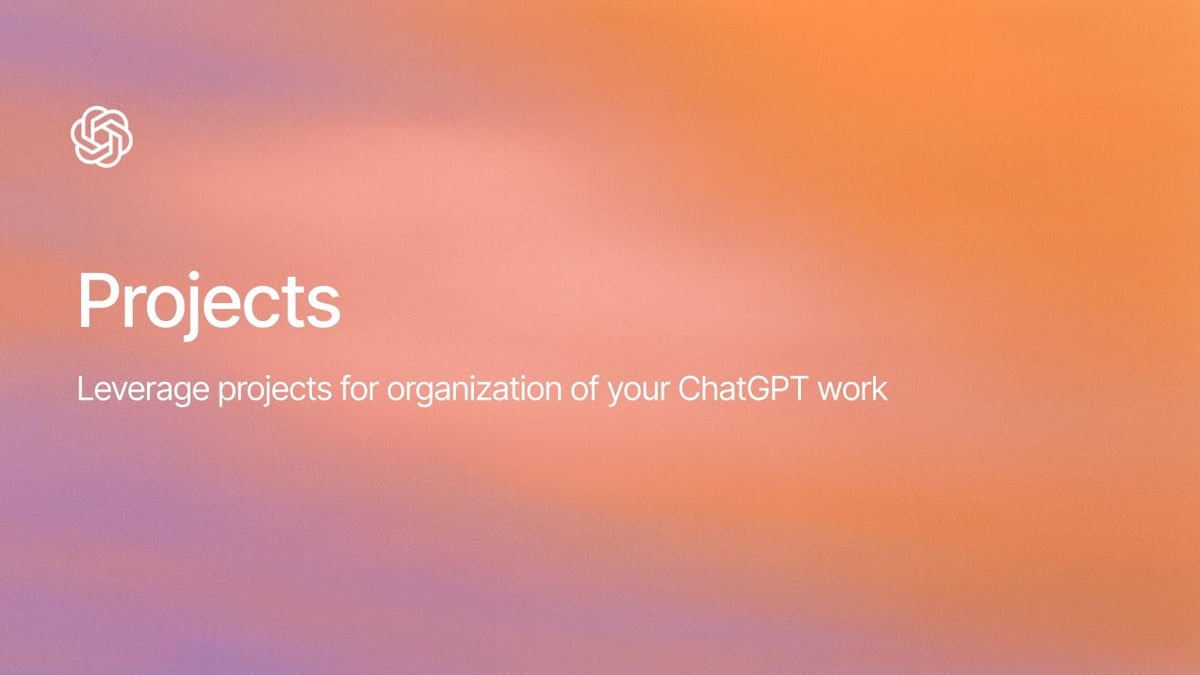New! Shared projects

# Work Users
# Advanced Features
Organize your ChatGPT work—now with team collaboration
July 23, 2025 · Last updated on September 25, 2025
What are projects?
9/25/2025: Projects now allow for collaboration with other team members. Check out our blog announcement here.
Projects in ChatGPT let you organize work into dedicated spaces where you can gather context, files, and instructions. You can now invite teammates to collaborate in the same project—making it easier than ever to align on goals, share progress, and build together in ChatGPT.
Example: A marketing team working on a campaign can create a project with brand guidelines, campaign briefs, and draft content, and then invite teammates directly in the same project so they can keep tone and style of all of their assets consistent.
Why it’s useful at work
Projects turn ChatGPT into a true team collaboration tool.
- Centralize all instructions, files, and context so the model has the same background your whole team does.
- Ensure consistency across deliverables by giving teammates a single source of truth.
- Speed up teamwork by letting team members contribute directly, instead of copying and pasting between chats.
- Create repeatable workflows that teams can reuse across projects.
Try it out
- Go to Projects in the left-hand menu.
- Create a new project and give it a name.
- Add context: upload files, set custom instructions, or link relevant resources.
- Click Share and invite teammates by email.
- Start collaborating—everyone can now add context, create tasks, and chat with the same project.
Use cases for your role
Role | Top Use Cases |
Marketing | Share campaign briefs, align on messaging drafts, centralize brand assets |
Sales | Build shared account plans, draft client emails together, organize discovery call notes |
HR | Create onboarding playbooks, draft policies with legal, collaborate on employee comms |
Finance | Work on budget models, track reporting files, document assumptions |
Product | Centralize PRDs, research, and roadmap notes with engineering and design |
Projects vs. GPTs
Projects and GPTs both help you streamline work and bring context into in ChatGPT, but they’re designed for slightly different purposes:
- GPTs are customized, private versions of ChatGPT—“single-player” by design, even if shared across a company. They’re discoverable in an internal GPT store, built to scale knowledge top-down, and remain static and curated by internal creators.
- Projects are structured containers where teams upload files, share chats, and preserve evolving context around a topic or workstream. They enable collaboration, organize work, and build shared knowledge over time as people add chats and files.
| GPTs | Shared Projects |
|---|---|---|
Best for |
|
|
Outcomes |
|
|
Project-only memory
Project-only memory is useful when you want to create a dedicated context environment, avoiding any context spillover from other work. This is especially useful for client management or multi-phase projects where you want ChatGPT’s context to stay anchored to that project’s specific tone, feedback, goals, and history. When you choose project-only memory during project creation:
- Your previously saved memories are not referenced during chats
- Chats can reference other conversations within the same project
- Chats cannot reference conversations outside the project (such as general ChatGPT or from a different project)
Note: To use project‑only memory, enable Reference saved memories and Reference chat history in your personal settings. Additionally, It’s available only for ChatGPT Enterprise and ChatGPT Business users when Memory is enabled at the workspace level.
Examples for when to use project-only memory:
- Scenarios where memory containment and context clarity are essential. With project-only memory, ChatGPT’s context is only ever about that particular reporting workstream, and your feedback and decisions around it.
- Long-running work, like client accounts or monthly reporting.
- Sensitive projects, such as stealth project planning or employee reviews, where users don’t want cross-contamination with other chats.
Additional considerations
- Permissions: Only project owners can invite or remove collaborators.
- Version control: Everyone sees updates in real time—no need to manage multiple versions of a file.
- Best practice: Add clear instructions in the project so teammates know how ChatGPT should respond in that shared context.
- For Enterprise customers: Shared projects come with Enterprise controls to manage access, protect data, and meet compliance requirements. Admins can enable or disable the feature at the workspace level, or manage availability by group through role-based access controls.
Related resources
- OpenAI Blog: More ways to work with your team (September 2025)
Table Of Contents

